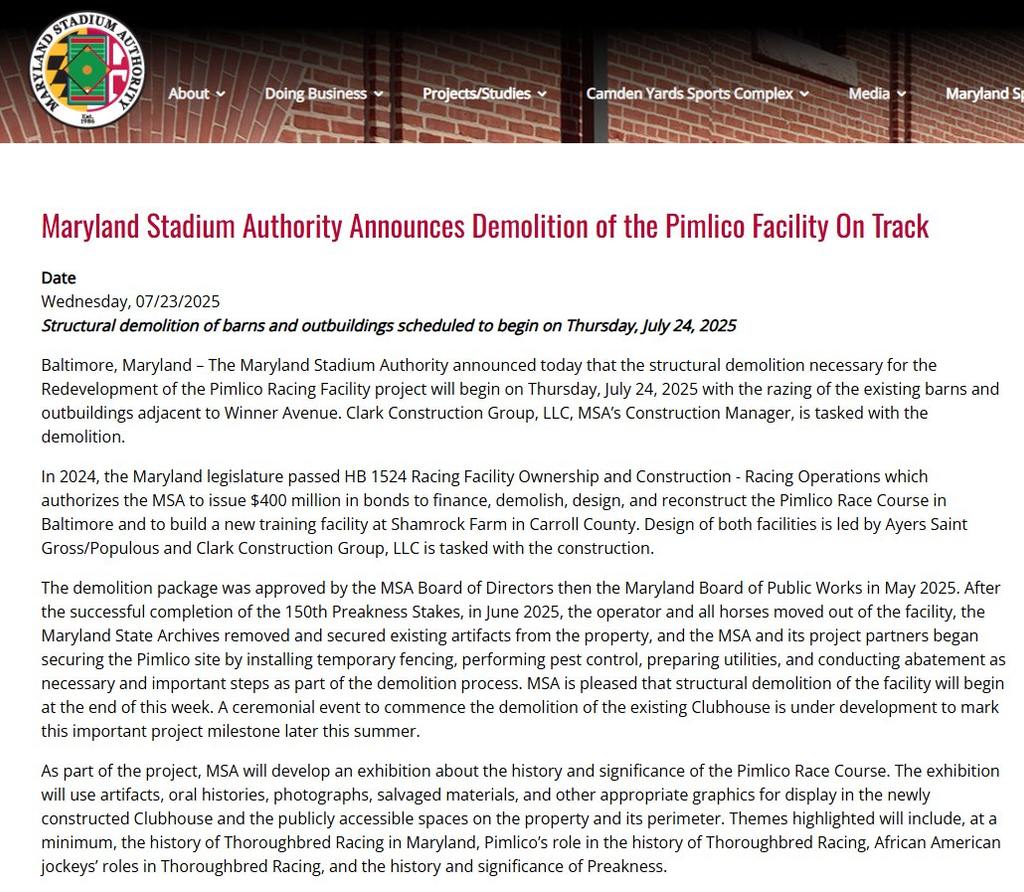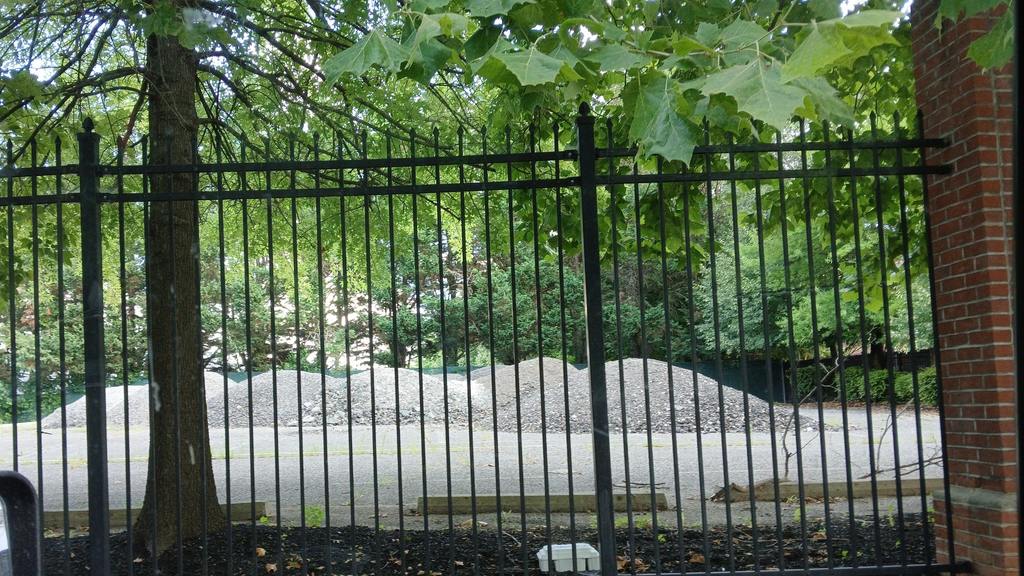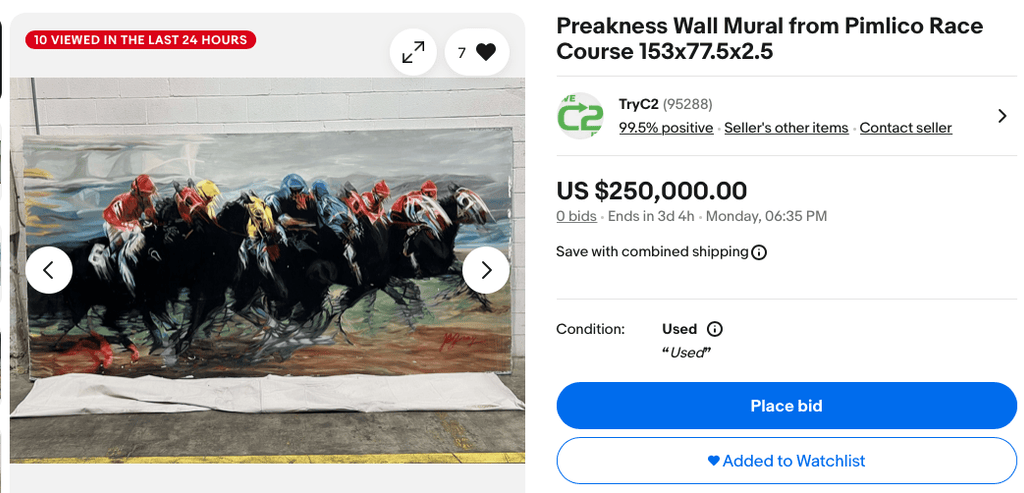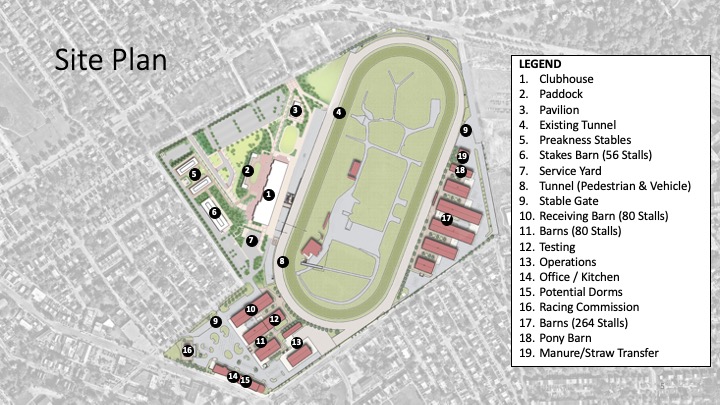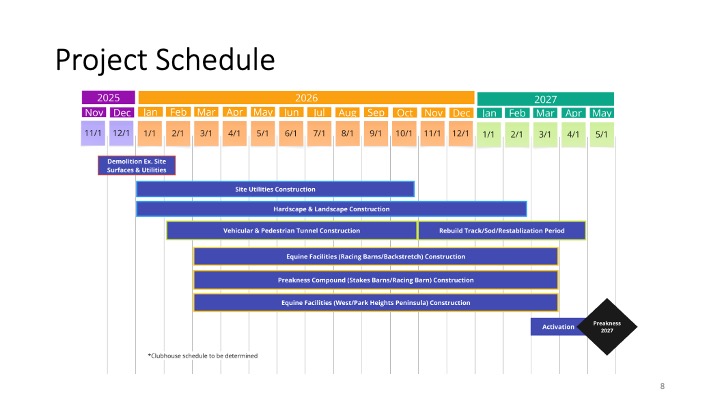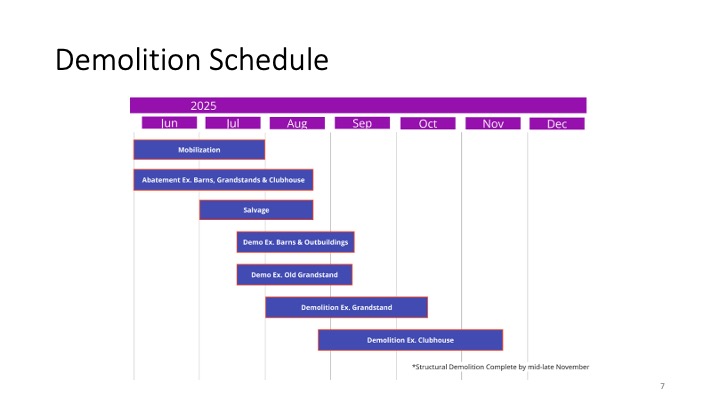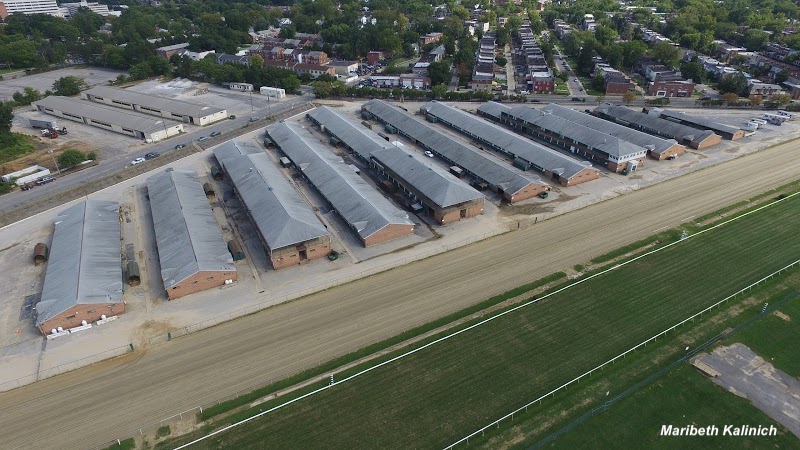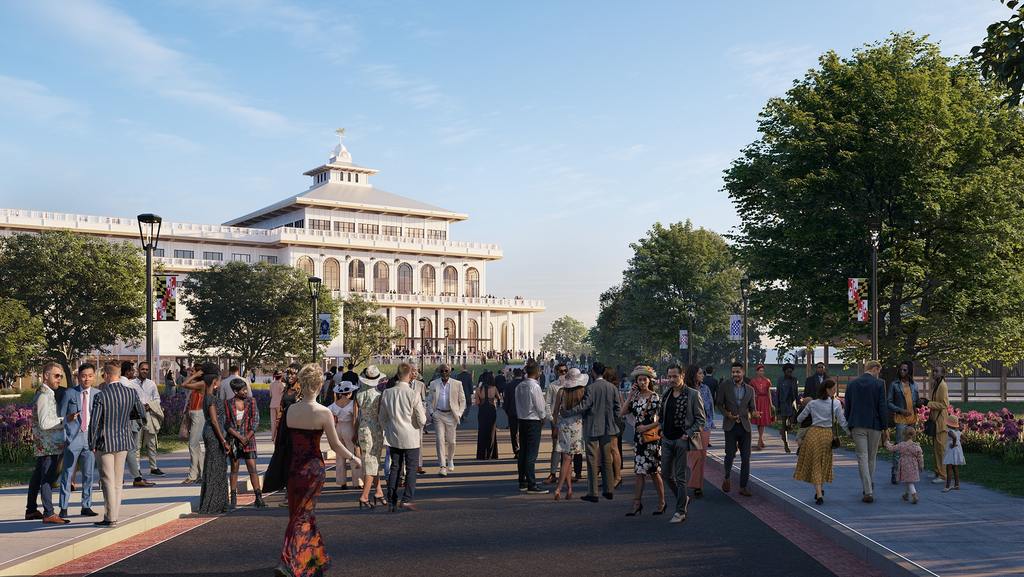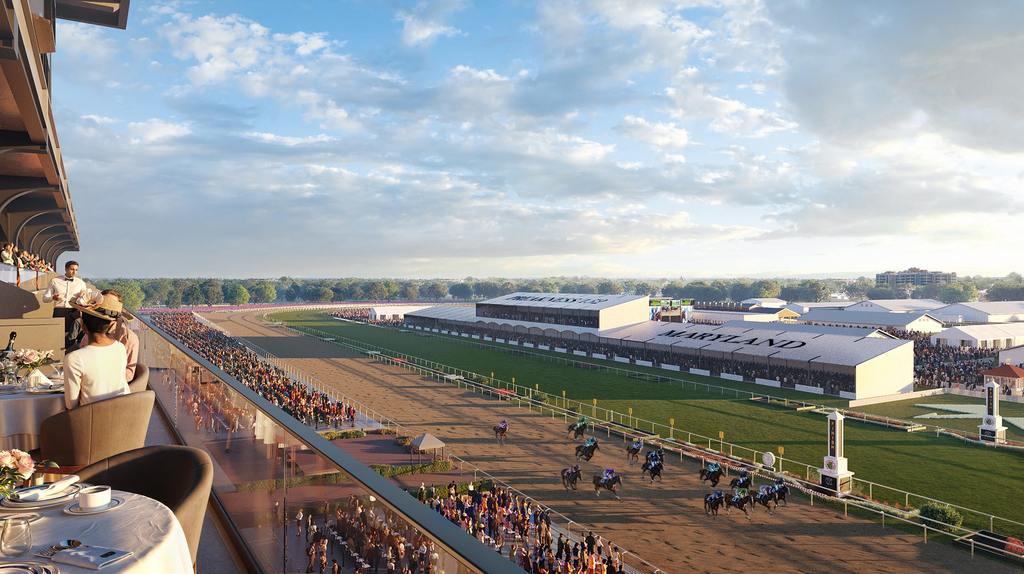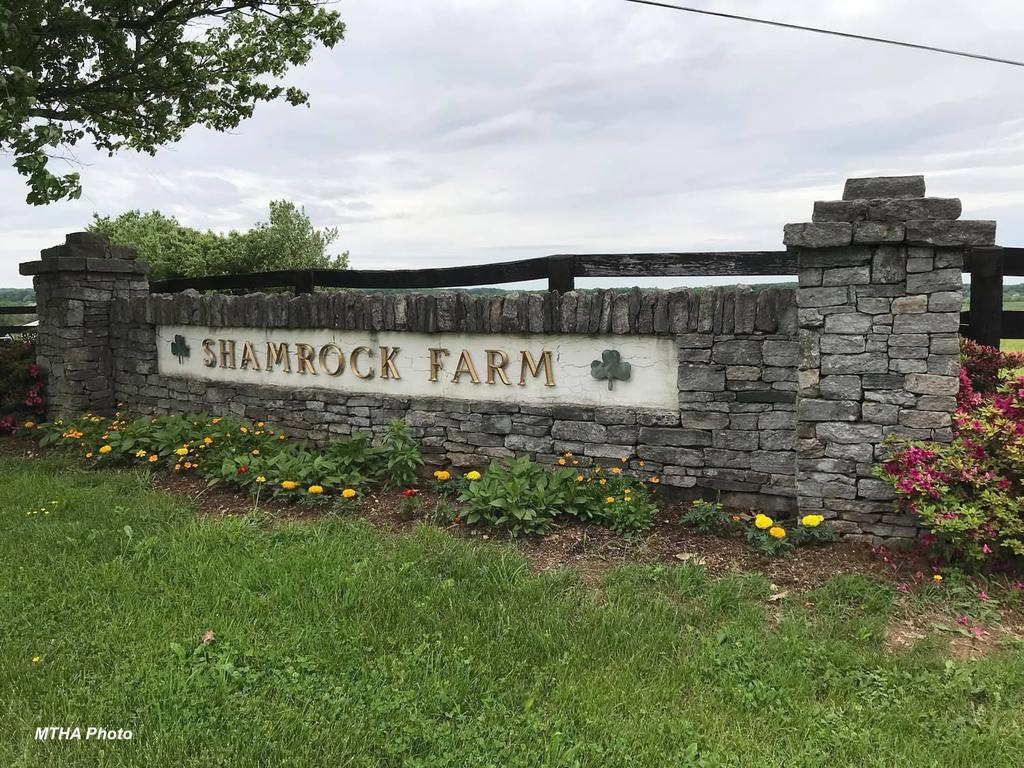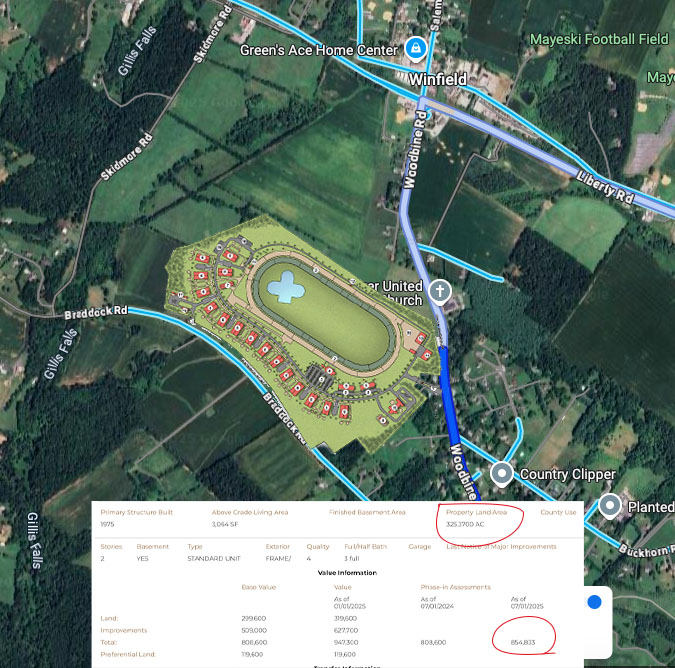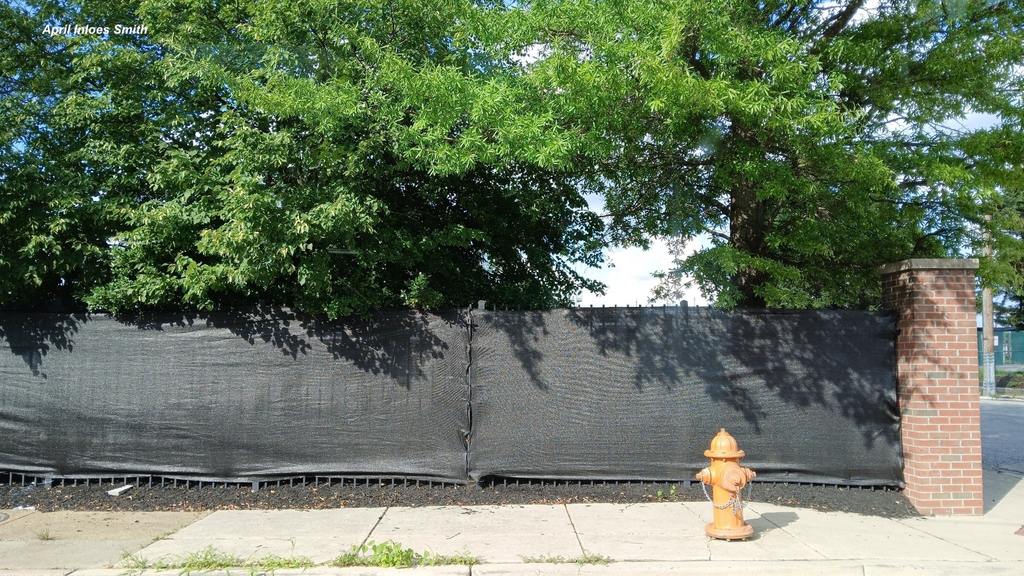
A black fence has been installed around Pimlico as demo begins. (April Inloes Smith)
Compiled and Written By Maribeth Kalinich
UPDATED 7/23/2025 11:30 PM EDT
The 150th Preakness has been in the books for two months and news reports stated Pimlico would see the start of demolition by July 1. So, what is really happening with the Pimlico Plus Plan?
There has been some movement at the facility and a black construction fence installed. There is gravel piles and construction equipment but so far, we know of no structures that have been destroyed.
This project is multi-faceted beginning with preparations for the first phase of demolition and sending out bid packages for the other five phases.
The first phase includes exterminating dozens and dozens of rodents before they can begin to raze the buildings.
The historical significance needs to be addressed before any demolition can occur.
The reality of the project began the week after the Preakness with an online auction dismantling parts of Pimlico including the teal seats in the grandstand, historic signage, and other items such as an entire bar and the neon sign outside of the Triple Crown Room.
We can report that the sign recognizing Sir Barton’s Preakness victory was purchased by freelance racing photographer Eric Kalet and sent to author Jennifer Kelly in recognition of her book, Sir Barton and the Making of the Triple Crown.
A large format photograph of American Pharoah scoring the Preakness on his way to breaking the long-standing Triple Crown spell was also auctioned for $192.
The historic image, capture by long-time Maryland track photographer Jim McCue, spanned the Pimlico grandstand was recently listed on eBay for $50,000 plus shipping. There were no bidders.
Another rather mysterious item was for sale on eBay—a large mural of racehorses painted right onto the wall somewhere outside of the Triple Crown Room on the second floor of the grandstand.
Barely visible due to its location, the mural was literally cut out of the wall.
The 153 x 77.5 x 2.5 inch artwork is signed “JGray” but the artist is not confirmed. There is no provenance for the piece that was offered at an opening bid of $250,000. Again, there were no bids on this item.
A large format photo of California Chrome mounted above the teller’s windows in the grandstand has yet to surface in any auctions.
Mr. McCue has reported that he and former MJC President and GM Mike Rogers had begun conserving the historic Pimlico and Preakness photography which has been sent to the National Museum of Racing and Hall of Fame for conservation.
Changing of the Guard: MTROA Sees An Early Sunset
The Maryland Thoroughbred Racing Operating Authority (MTROA), instituted by the legislature in 2023 and scheduled to sunset in 2027, was given an early exit of June 30, 2025—one year and six months after they submitted their comprehensive reports regarding Pimlico, racing in Maryland, breeding and the proposed training center.
As one of their last official acts the MTROA appointed the Board of Directors for the newly formed The Maryland Jockey Club (TMJC).
The Maryland Stadium Authority (MSA) now assumes the renovation responsibilities with the nascent TMJC overseeing racing and the Maryland Economic Development Corp. (MEDCO) administering the facility once completed.
Greg Cross, chair of the now defunct MTROA, commented, “I could not be more thrilled that this all-star group has agreed to volunteer their deep experience and time to take the baton from MTROA and build off of the new foundation that is in place for Maryland racing as we look to the future.”
Working Out the Historic Status
In accordance with the Maryland Historical Trust Act, MSA initiated consultation with the Maryland Historical Trust (MHT) to resolve the adverse effect on the historic properties. MSA reached out to my organization, Friends of Pimlico, and others to participate in the consultation on June 2nd.
Until the issues of adverse effects are resolved there can be no demolition as was stated at the consulting meeting.
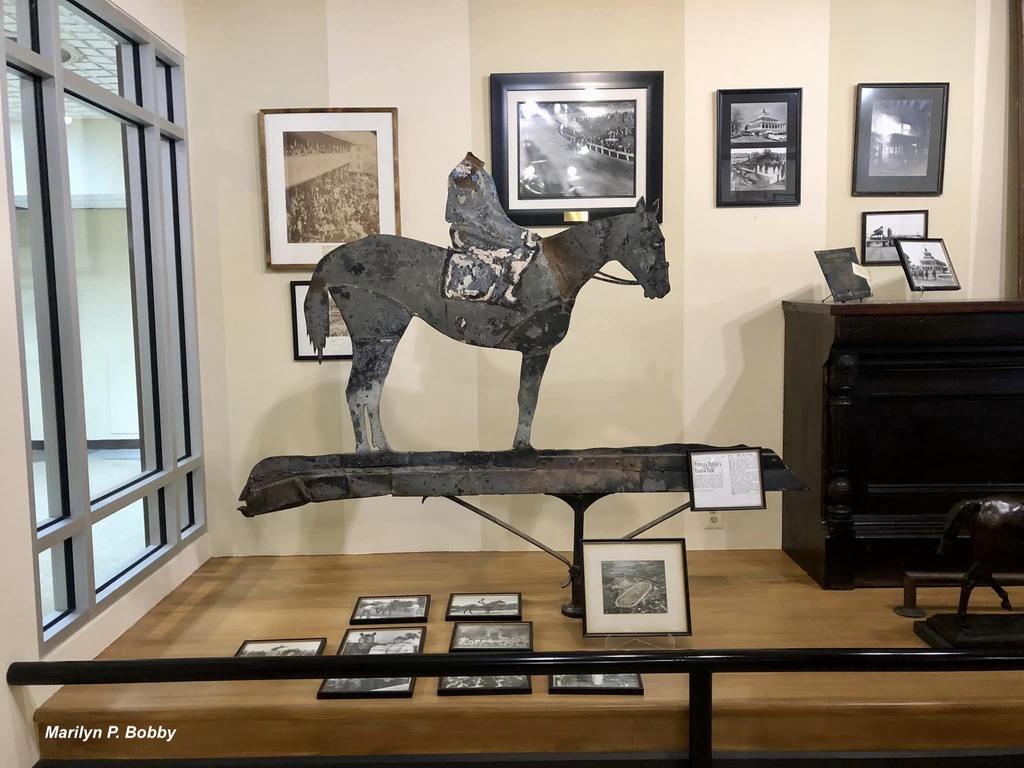
As stated in the MHT’s “Revised Effects Assessment”:
“After consideration of the Project’s design changes, MSA continues to recommend that the undertaking will have an adverse effect on Pimlico Race Course dues to the demolition of numerous buildings and support structures. Although the track will no longer be demolished and reoriented and will, therefore, retain its historic integrity, the Project still involved demolition of multiple buildings constructed during the period of significance (1894 to 1968) that are considered contributing structures.
Fifteen contributing features north of the track and 10 in the back stretch will be demolished, including the grandstand, clubhouse, support buildings and stables. The removal of these significant contributing features would constitute an adverse effect on the historic property, as their removal would alter the character of Pimlico Race Course and diminish its historic significance. The potential for visual effects is high with the addition of new stables, barns, support buildings, an office, and a clubhouse.”
The current proposed plans level everything on the property to the ground. However, if all that is historic is removed will Pimlico lose its historic significance? That will be decided by the MHT.
They are proposing to “document” all of the historic aspects with photography and personal accounts and stated that should be sufficient for the historic status on the National Register of Historic Places (NRHP)
An application was submitted for to NRHP through the MHT.
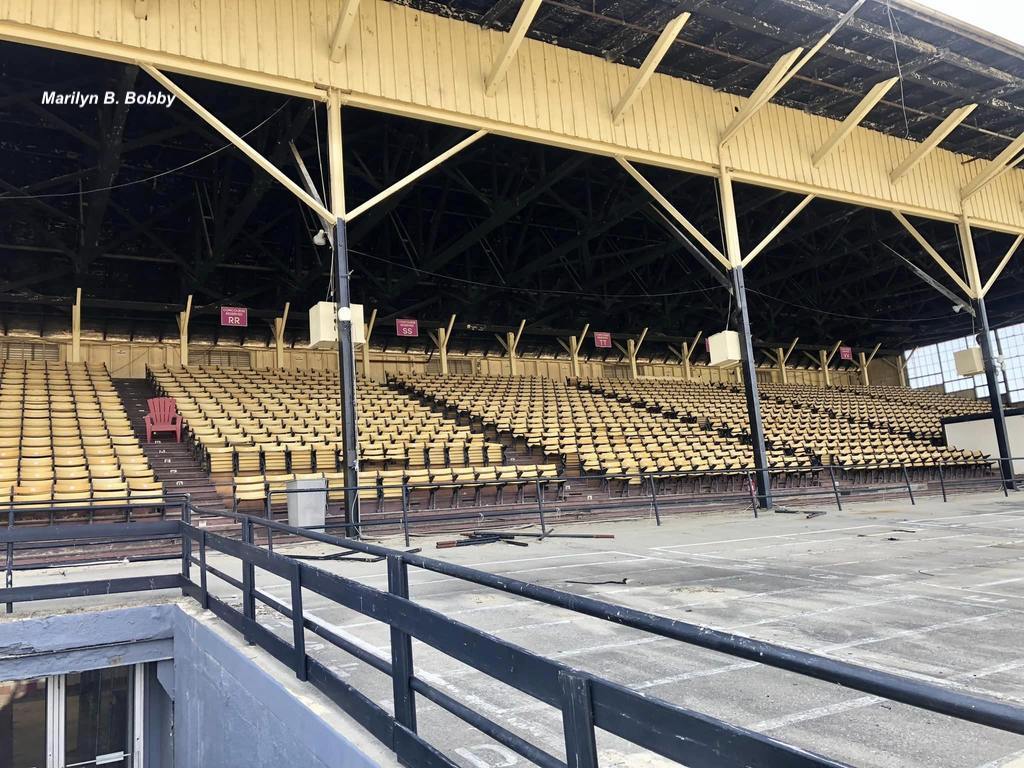
To be added to the Register Pimlico had to qualify in at least one of three criteria. The historic facility was said to qualify for Criterion A and C but not B that pertained to historical persons associated with Pimlico.
Criterion A
Pimlico Race Course has a significant association with the large-scale introduction of Thoroughbred horse racing in Maryland. While Thoroughbred racing had been happening in Maryland prior to 1868, no race course had the same effect on the sport’s popularity as Pimlico.
Criterion B
Pimlico Race Course is recommended not eligible for the NRHP. Research has revealed no significant association with persons who have made specific contributions to local, state, or national history.
Criterion C
Pimlico is a significant example of an early-twentieth-century racing track adapted to reflect the changes in horse racing trends and technology through the mid-twentieth century. The race track contains a representative, intact collection of late-nineteenth- century, early-twentieth-century, and mid-twentieth-century buildings.
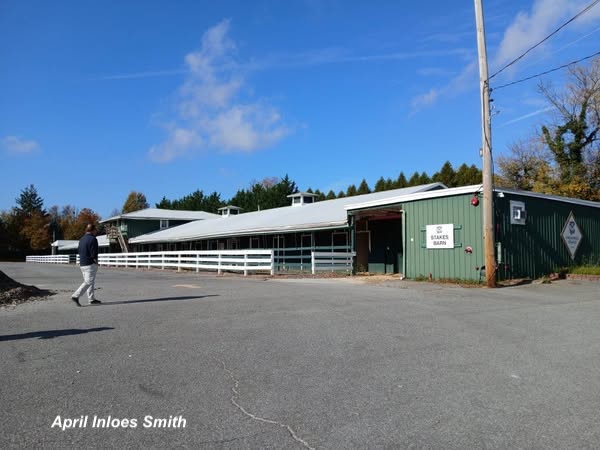
To read all of the Criteria click here.
Because we feel Pimlico does indeed have historic persons, through Friends of Pimlico we submitted information to the MHT regarding those persons.
Those noted include William Riggs, who brought racing back to Pimlico and instituted the parimutuel system in the early 1900s, Sam Riddle, owner of Glenn Riddle Farm and champion Thoroughbred Man o’ War, and Alfred Vanderbilt, Jr., former MJC President and owner of Sagamore Farm. Click to read more.
We are currently awaiting the “Memorandum of Agreement” from the MHT that was just approved in draft by MSA at their most recent board meeting.
Note: The large multi-panel murals created by Raoul Middleman and his students from 1975 to 1980 are not included in the period of significance. They may be sent to the Maryland Institute College of Art (MICA), where Middleman was a professor, for conservation and not a part of the new Pimlico.
Progress Update
At the Commission for Historical and Architectural Preservation (CHAP) Meeting held at Lifebridge/Sinai on Tuesday, July 15, a new site plan and additional plans were revealed.
The site plan now has the previously big blank white space filled in where there will be a much smaller clubhouse with no grandstand. The new outdoor paddock will be tucked behind the clubhouse with the one noted stakes barn containing 56 stalls nearby.
Also noted on the plans is a “pavilion” with no description of what that will actually contain or what function it will serve.
There is no indication of a planned museum to house the many artifacts that were removed from Pimlico.
New demolition and project schedules were presented during the PowerPoint presentation.
The demo schedule began in June with “mobilization” and abatement to the barns, grandstands and clubhouse.
Abatement is the process of permanently removing known hazardous material in surface areas and also includes encapsulation, which is sealing off hazardous materials. Much of Pimlico contains asbestos and other such materials.
In the project schedule, demolition of the existing site, surfaces and utilities extends from November 2025 through the beginning of February 2026. The structural demolition is noted to be complete by mid to late November.
Although the actual racing oval will no longer be “reoriented” the actual racing oval will require rebuilding due to disturbances from demolition and construction saving an estimated $30 million in construction costs and accelerating the construction timeline.
Rebuilding the track isn’t scheduled until November of 2026 and is slotted until the end of April.
However, before any construction can take place, the site utilities must be complete, which is on the schedule from January until the end of October 2026. There is a footnote that the clubhouse schedule is still to be determined.
Replacing the rows of brick clad barns on the backstretch will be five barns containing 264 stalls. On the clubhouse turn will be the receiving barn (80 stalls) testing barns and an additional structure noted as “barns” with 80 stalls.
In earlier announcements it was stated that “hybrid” barns (semi-permanent tent barns) would be constructed but it is not noted in recent announcements if all barns would be of this style.
What Will and Won’t Be …
The plan is to demolish and replace the expansive open grandstand built in 1922, the enclosed grandstand built in 1954, and the Mid-Century modern clubhouse built in 1960 (in only six months between the Spring and Fall meet at Pimlico).
Also earmarked for demo are the brick-clad barns on the backstretch that contain workers housing and the green wooden stakes barns on the other side of the property where the elite horses were housed during the Preakness.
“Approximately 40 new buildings will occupy the revitalized 117-acre (110 acres) Pimlico Race Course with a design inspired by the original grand Gothic-style (Victorian) clubhouse built when Pimlico opened in 1870. Pimlico’s new horse barns will take a similar approach, housing 400 horses and providing space for non-race-related events,” states a report about the plans.
“The proposed plans are for a smaller grandstand area with a 5,000-seat capacity. The facility will double as a 1,000-seat event space open year-round. A dining facility is also planned, along with a sports book, a hotel with views of the track, and a 2,000-space parking garage,” the report further states.
When questioning the relevancy of the hotel we were told that is a project being handled by an outside developer and not part of the Pimlico project. When pressed who that developer would be we were not given an answer. At the recent CHAP meeting the hotel was not even mentioned.
Currently the main grandstand built in 1954 holds 5,691 patrons with additional seating for 1,269 in the clubhouse, 160 in the sports palace and 1,806 in dining. The old grandstand built in 1922 that was “decommissioned” in 2019 held 5,926. There is a total capacity in these areas of 8,926 patrons.
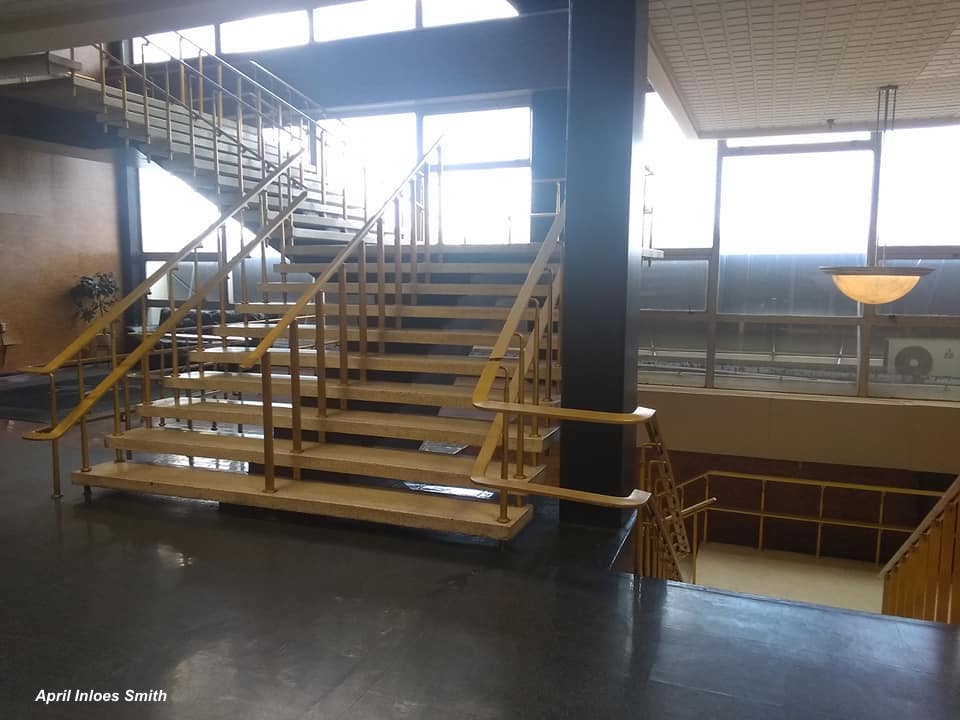
The current Pimlico Stable Area has 665 stalls, plus tack and feed rooms and 132 sleeping rooms on the second level.
There is nothing on the plans that denote any worker’s quarters and it had been proposed that this would be set up off-site.
The 2024 legislation allotted $300 million in investments for Pimlico with another $100,000 million for the training center. This funding will come from the sale of bonds by MSA that were supposed to be sold this summer.
What funding doesn’t come out of the bonds will come out of racing’s casino slots revenue existing funds from the Purse Dedication Account (PDA) that supplements the horsemen and Racetrack Facility Restoration Account (RFRA) that was mostly used for Laurel Park when applicable to an operational track (Laurel Park will be closed and it’s rumored Stronach will sell the property).
Demolition and Construction Phases
Clark Construction Group, in partnership with McKissack & McKissack and THG Companies, is assembling a team of project partners for the “Redevelopment of the Pimlico Racing Facility” on behalf of MSA, the agency managing the project.
Clark Construction Group will oversee demolition of Pimlico’s 65-year-old clubhouse, horse barns and other buildings under a $14.3 million guaranteed maximum price contract with the Maryland Stadium Authority.
This funding was obtained in May just before the 150th Preakness by MSA at a Board of Public Works meeting (MBPW) after they gave a first glimpse of architectural renderings of the new Pimlico with a Victorian flavor.
Gov. Wes Moore, who chairs the MPPW board, told Maryland Matters the new track, once completed, will “become a year-round hub for economic activity within Park Heights” and “serve to revitalize Maryland’s horsing industry,” an industry he said accounts for 28,000 jobs and $3 billion in economic activity.
Some have questioned the value of using state taxpayer dollars to save an industry that has struggled for decades.
At the MBPW meeting Board Member and Maryland Treasurer Dereck Davis questioned whether this latest effort represents the state’s final attempt to steady a struggling industry.
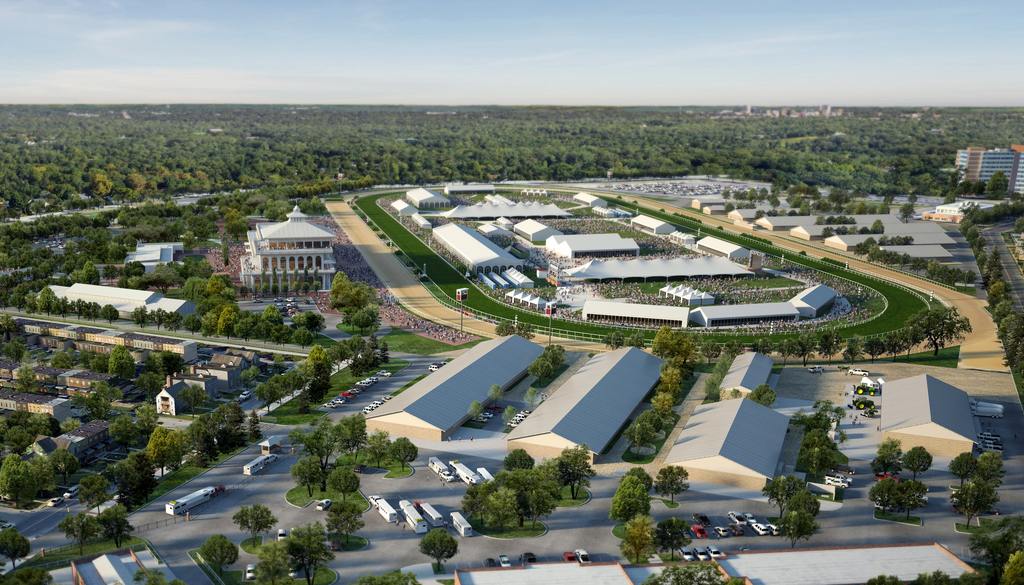
“The state, with the implementation and subsequent completion of this project, we will have done everything we could do to make racing successful, other than the third weekend in May every year” when the Preakness is run, Davis said.
Davis wondered aloud if remaking Pimlico and consolidating thoroughbred racing at the track would save the industry.
“Is there anything left that I guess we can do or — this has to be successful, I guess is what I’m getting at. The state’s invested a lot of money over the years. This has been an issue since I first came to Annapolis, literally 30 years ago,” Davis added.
“I guess what I’m asking, is this just a pipe dream, quite frankly, … can provide racing, or is it just sort of a niche thing that we enjoy every third weekend in May, and then it’s just sort of out there waiting for the next May to come?” Davis asked.
In October 2024, the state contracted with Clark for approximately $900,000 in preconstruction work.
Earlier this year, Clark advertised trade bid packages for site and structural demolition, hazmat abatement, erosion/sediment control, electrical/water, pest control and other services, with a 35% Minority Business Enterprise (MBE*) participation goal.
Guaranteed Maximum Price (GMP**) Bid packages were issued beginning in March 2025. Package 1 that begins phase 1 of the plan included temporary fencing installed around the site to ensure safety and security during construction.
Pest control procedures will be implemented to minimize disruption to the surrounding area.
Mechanical, electrical, and utility “Make Safe” work will include cutting and capping existing systems to prepare for demolition. Utility disconnections are expected to affect only the Pimlico facility, with no anticipated disruptions to surrounding properties.
GMP #1 has eight divisions that include: Pest Control, Construction Trailers, Structural Demolition, Abatement, Erosion & Sediment Controls, Site Demolition and Water Utilities (Cut/Cap Existing, Temporary Utilities). The estimated cost is $5,000,000 – $15,000,000.
GMP #2 in two divisions included Pre-Engineered Fabric Structures and Pre-Engineered Metal Buildings.
Structural demolition of existing buildings on the site will begin in phases.
Construction office trailers will be installed to support on-site management and coordination as part of phase 2.
Full construction was expected to begin by July 1, 2025.
The bid for GMP #3 is out until July 31. With six divisions, this phase includes Site Demolition and Dewatering, Concrete and waterproofing the Tunnel and retaining walls, earthwork and utilities. The estimated cost is $50,000,000 – $100,000,000
The upgraded facility features a new clubhouse, paddock, racing barns, maintenance facilities, utility upgrades, sitework, and landscaping.
Work includes site enablement and the structural demolition of the grandstands, clubhouse, and equine structures, with a focus on salvaging historical elements. The upgraded facility features a new clubhouse, paddock, racing barns, maintenance facilities, utility upgrades, sitework, and landscaping.
In GMP #4 the barns, support and maintenance buildings will be addressed in phase 4 andawarded in August or September. It is not stated if this is a part of demolition or construction.
GMP #5, Scheduled in September or October is phases 5 referencing the “clubhouse core & shell”
GMP #6 is noted as clubhouse finished and landscaping with a bid/procurement time of the first quarter of 2026.
* The National Minority Supplier Development Council (NMSDC) defines a Minority Business Enterprise (MBE) as a for-profit business that is at least 51% owned, managed, and controlled by a member or members of a qualified minority group.
** Guaranteed Maximum Price (GMP) The amount established in a construction contract between an owner and a contractor or construction manager at risk (builder) as the maximum cost of performing specified work.
The Plus Part of the Pimlico Plan: Will Shamrock Farm Bring Luck?
Also, in early May the new training center to complement Pimlico took a major step forward when the MBPW approved the $4.48 million acquisition of Shamrock Farm.
Located in Woodbine, Carroll County, about 30 miles and an hour northwest of Pimlico Race Course, Shamrock Farm was selected by the MTROA out of a half dozen sites that were considered following a comprehensive site review and feasibility study MSA.
Some Marylanders have suggested the state look at Sagamore Farm as a possible location as it is half the distance from Pimlico and already has many required features available.
The Shamrock property will transfer to the state under the Maryland Stadium Authority (MSA). To date, the title has yet to transfer on the Maryland State Department of Taxation site.
On the taxation site the property is described as 325 agricultural acres with a house built in 1975. The taxation value is noted at just under $1 million, however, the estimated land value is approximately $3,547,537.
While the farm is over 300 acres, the plans published in the MTROA’s report state only 110 acres will be developed for the training center.
The planned facility is expected to accommodate more than 800 horses and will include a one-mile dirt training track designed to replicate the racing surface at Pimlico. Additional planned features include multiple barns, modern veterinary and administrative buildings, and on-site housing to support backstretch workers.
A $110-million allocation was approved last year by the state legislature to fund construction.
Carroll County has committed $1.5 million toward site infrastructure improvements hoping to underscore strong local support for a project. However, there is a bit of local criticism by those in the community including a Facebook group that opposed the project.
Construction is expected to begin as early as 2026 following the completion of a design and permitting process.
Shamrock Farm has been owned by the Rooney family, owners of the Pittsburgh Steelers, and has operated since 1948 as a premier Thoroughbred breeding and boarding facility.
In March 2025 there was a listing online of items from the farm for sale including several Pre Emissions John Deere Tractors, a 2012 Chevy 2500 HD 4×4 gas 69,290 miles, a 1997 Ford F250 4×4 138,075 miles, a New Holland BR770 Round Baler, a 1998 Mobile Home w/ title and a New Idea Manure Spreader.
UPDATE:
Right after this story was published Maryland Stadium Authority issued a statement that demolition on Pimlico would begin on Thursday. Well, they can’t. We have yet to finalize the MOA.
From the June 2 historical consulting meeting minutes:
Maribeth: Will this mitigation process be completed by the time the demolition begins in July? Can any demo begin until this is resolved? Karen (Hutchins-Keim) confirmed the MOA needs to be executed before demolition can begin.
And this proposal is nowhere good enough:
“As part of the project, MSA will develop an exhibition about the history and significance of the Pimlico Race Course. The exhibition will use artifacts, oral histories, photographs, salvaged materials, and other appropriate graphics for display in the newly constructed Clubhouse and the publicly accessible spaces on the property and its perimeter. Themes highlighted will include, at a minimum, the history of Thoroughbred Racing in Maryland, Pimlico’s role in the history of Thoroughbred Racing, African American jockeys’ roles in Thoroughbred Racing, and the history and significance of Preakness.”
